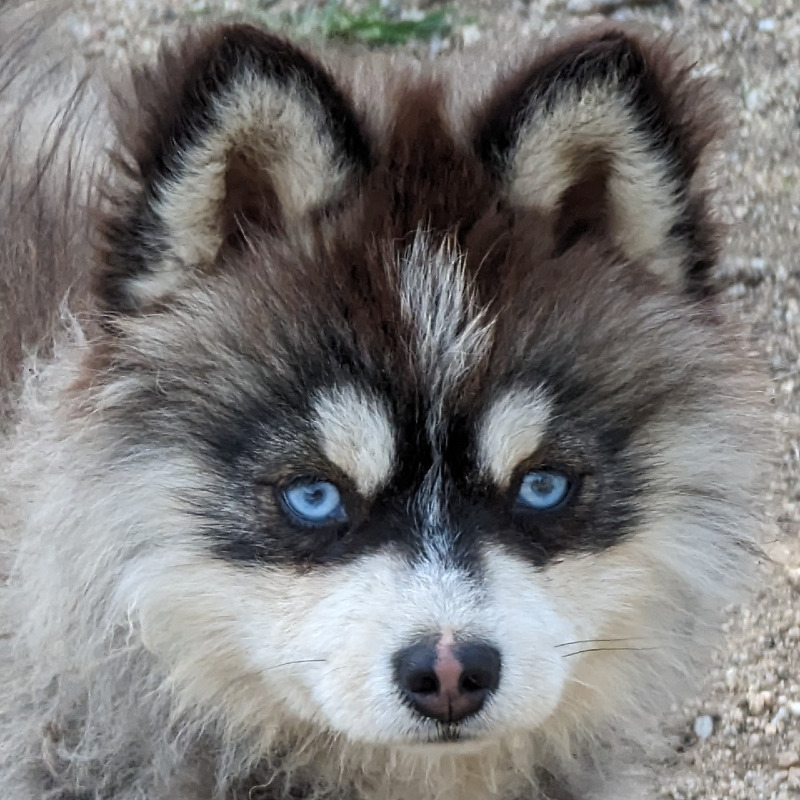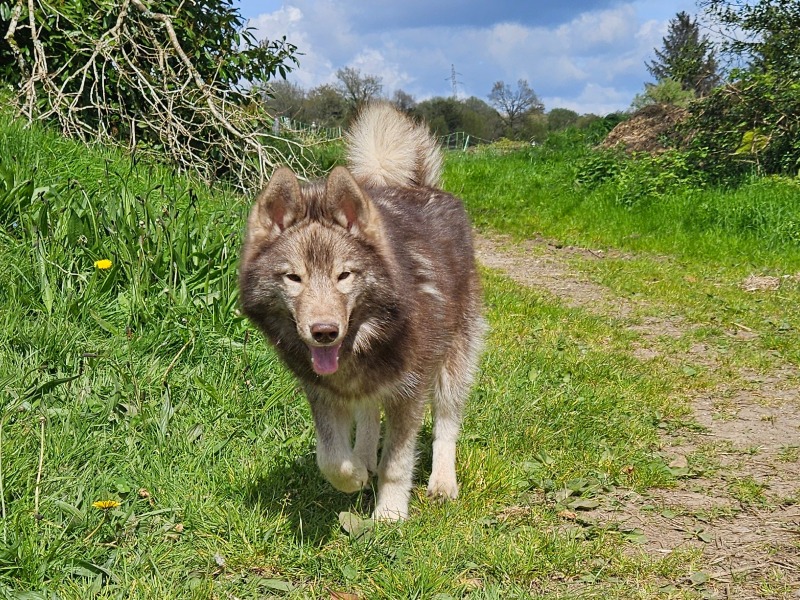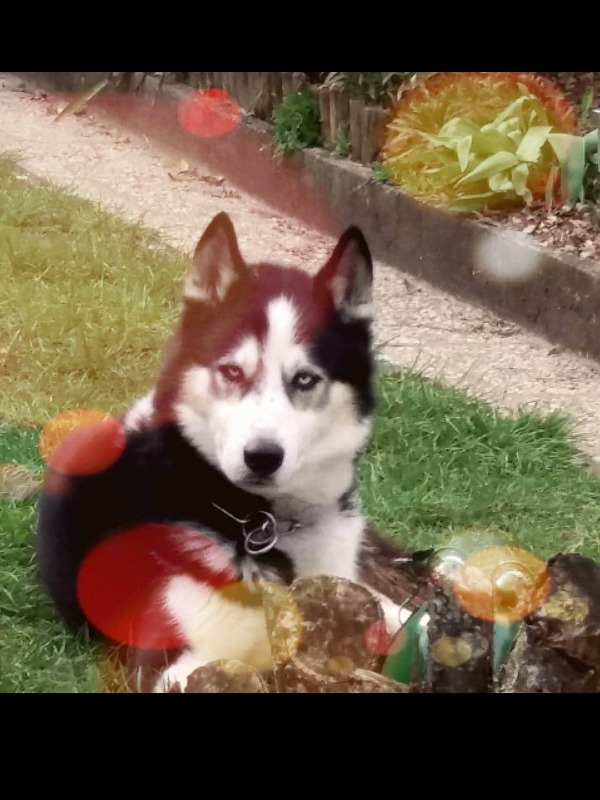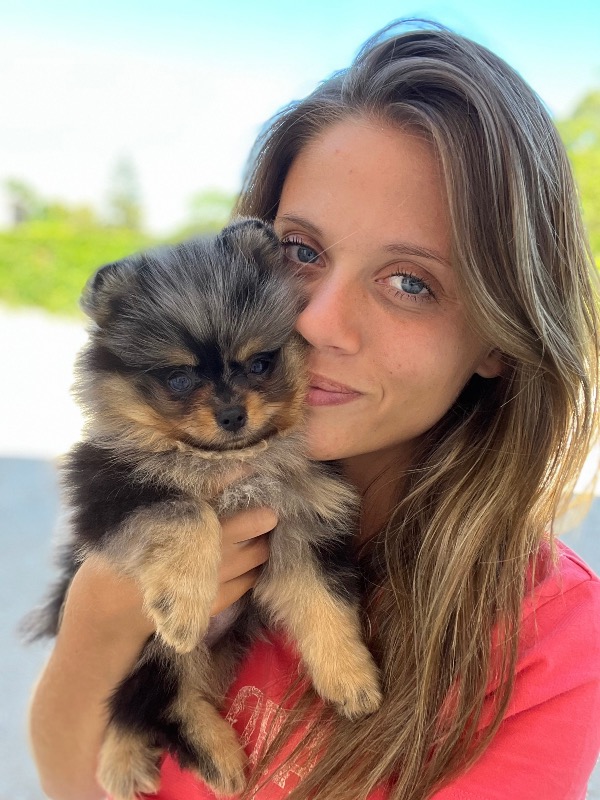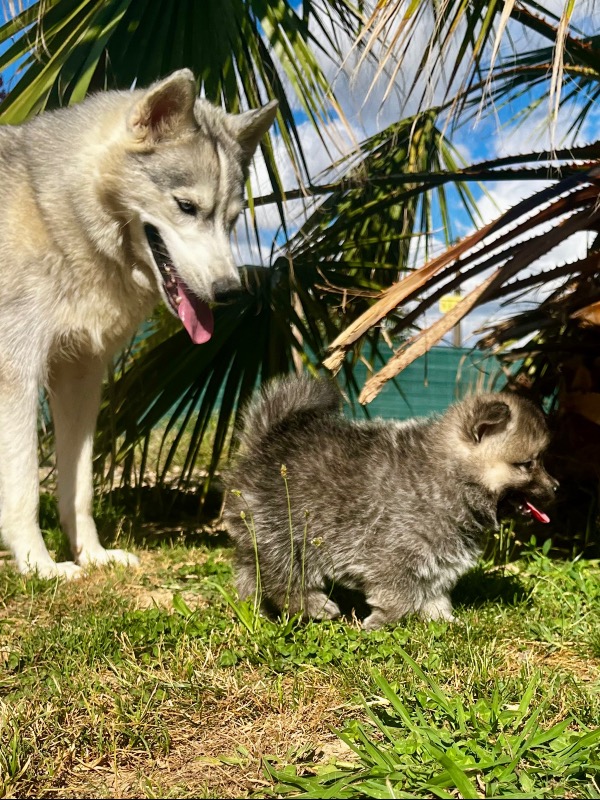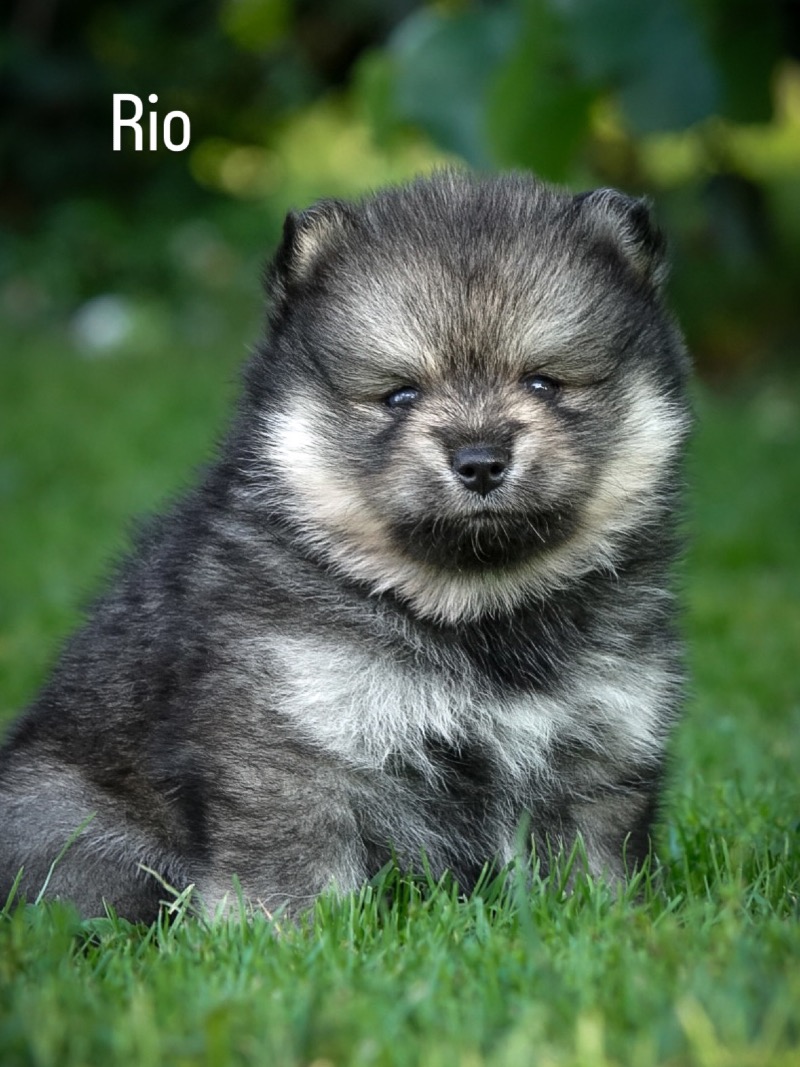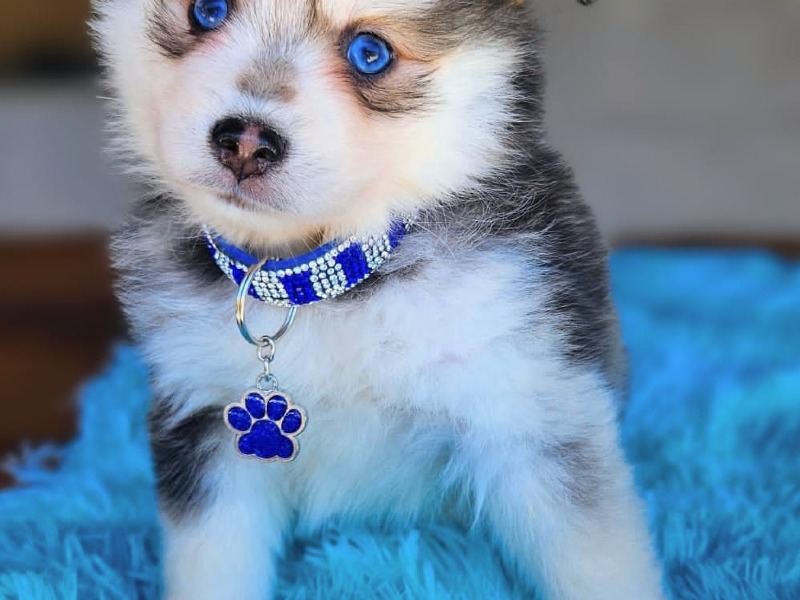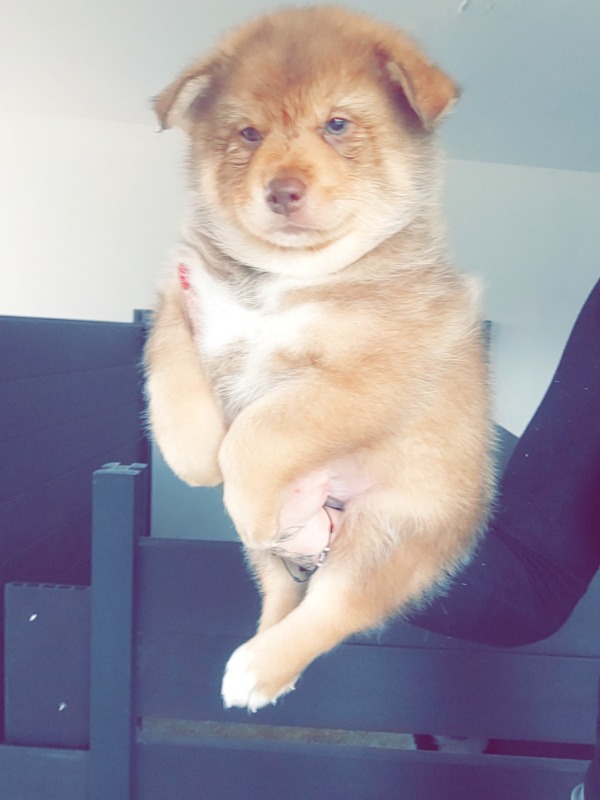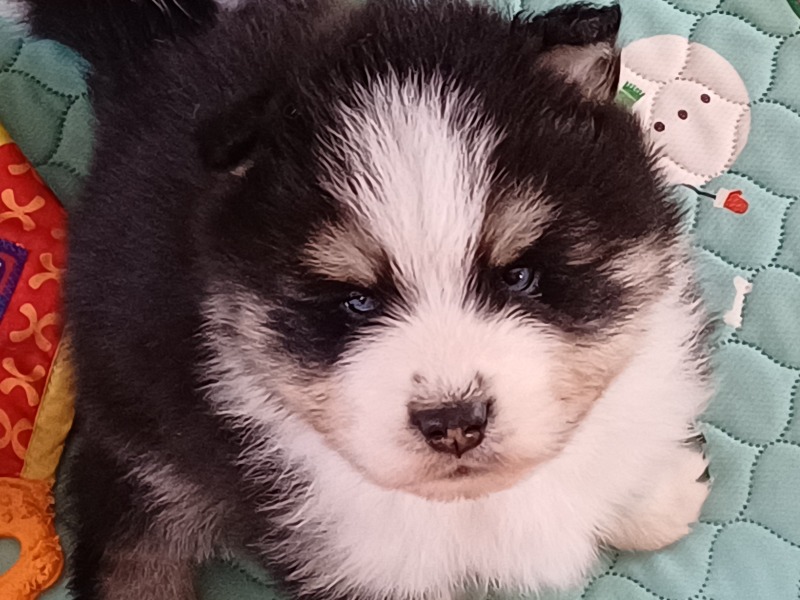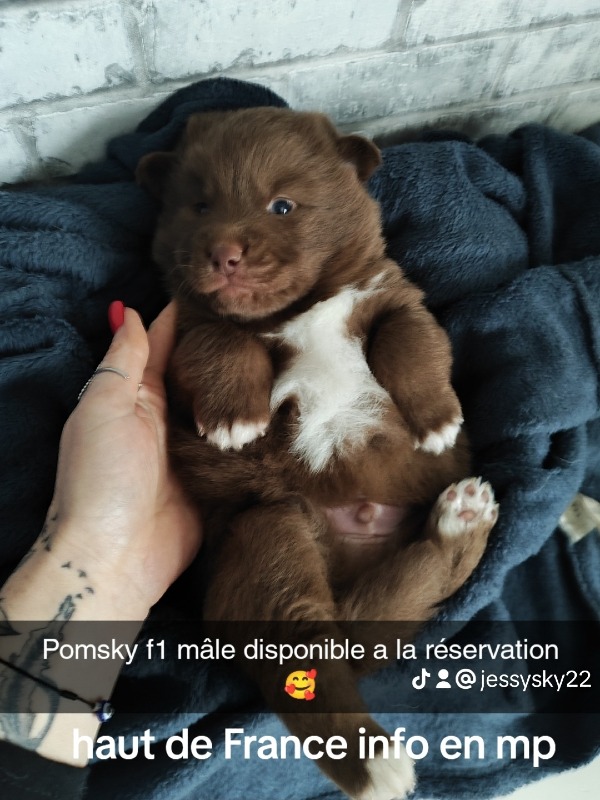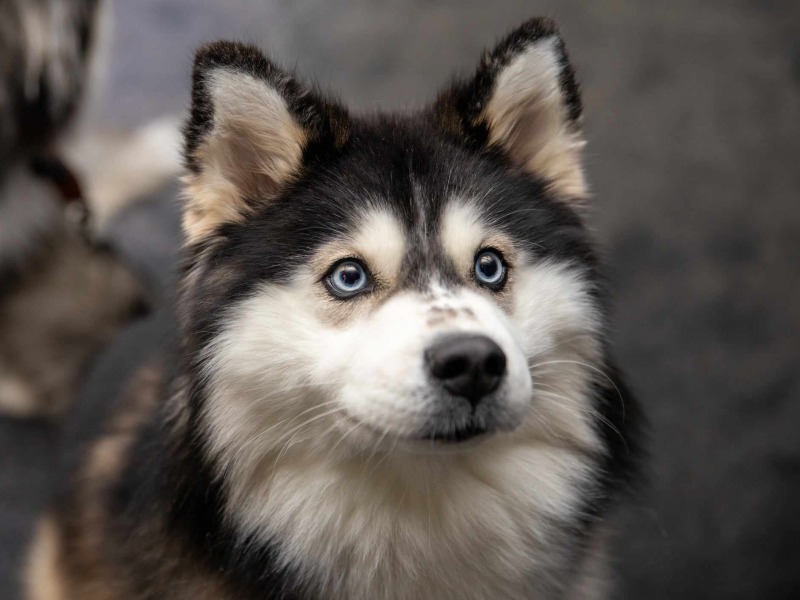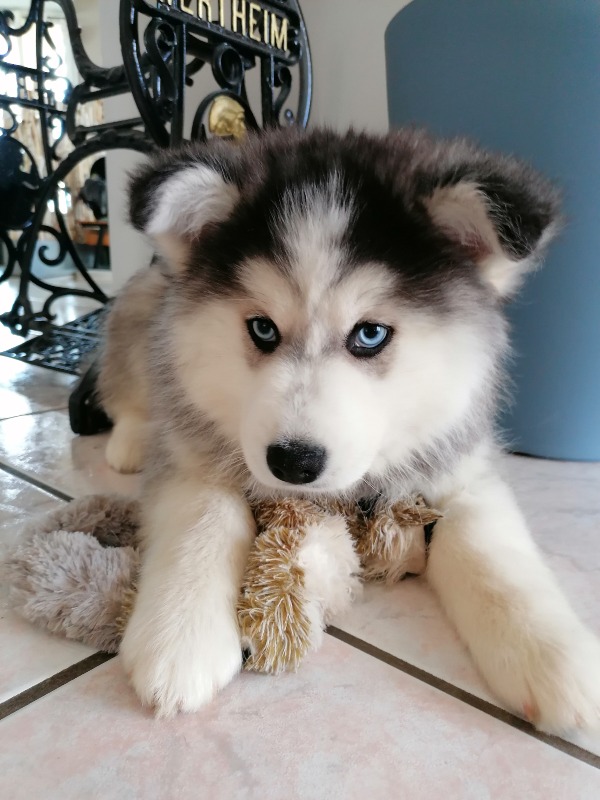Pomsky
Welcome to our page dedicated to the breed of dog pomsky!
Here, you will find all the useful information about pomsky. This descriptive profile will allow you to discover the aspects of this breed. You can notably consult information about the average price, monthly and annual upkeep expenses, their health, name ideas, as well as their official recognition by competent authorities.
Explore this page to discover everything you need to know.
Overall description of the breed
The Pomsky is a hybrid dog breed from the United States, its origins and creation are recent, its first appearance dates back to between 2009 and 2012. It is a cross between the Siberian Husky and the Pomeranian Spitz. Its development goes back to ten years, the Pomsky is the result of a collaboration between two breeders, Joline Phillips "Arctic Design Pomskies" and Tressa Peterson "Apex Pomskies", who crossed a male Pomeranian and a female Husky.
Its success in North America and Europe was meteoric, growing from less than five kennels to more than fifty in a few years. The original standard is made up of these two breeds, however, some believe that the Pomsky has benefited from the addition of Malamut or Alaskan Klee Kai, in order to reinforce the voluminous aspect of its fur. As with all hybrid breeds, a rigorous selection process was put in place, with selection work on each generation, which gave rise to several categories of Pomsky ranging from F1 to F5. The F1 being the first stage of the cross between the Husky and the Pomeranian, the F5 corresponding to the perfect mixture of the two breeds, being able to be regarded as a true Pomsky.
As a young breed, still not very well established, it is not recognised by the International Cynological Federation, but by the official breed club, created by the founders, APKC, American Pomsky Kennel Club.
The Pomsky is a young breed, for this reason, we find variable morphologies as well as different aspects according to the crossings made. There are of course influences from the Pomeranian Spitz and the Husky, the aim being to create a perfect mix of these two breeds, to combine the robust physique, colour or marking of the Husky, with the small size and gentle character of the Spitz.
Their physical characteristics are relatively similar, a large body, thick and robust bones, a round head, with almond shaped eyes, combined with a medium length muzzle. Their ears are V-shaped, set high on the skull, a clean, compact topline ending in a tail that provides hair, curling over the back when the dog is in action. The coat of the Pomsky is medium long, voluminous and thick, combined with an abundant undercoat, offering him remarkable protection against low temperatures. All colours are permitted by the breed standard.
The character of the Pomsky is quite variable according to the lines and the temperament of the various subjects used, the majority preserved a primitive nature proper to the Husky, others will be more docile and close to the man, following the example of the Spitz Pomeranian.
His socialization and education are important subjects, they must be taken seriously from an early age, not very receptive to orders or obedience, he keeps an independent personality and not very docile. However, it benefits from a good reputation, close to humans, the Pomsky will appreciate the company of its owners, it will show itself peaceful indoors provided that its daily needs in energy expenditure are met.
They are remarkably adaptable and can thrive in both urban and rural environments. They are robust and full of life and can accompany you on your sporting activities. The Pomsky's popularity continues to grow year after year, thanks to its pretty face which gives it a ravaging charm, making it one of the most popular companion dogs of the future.
Adult: The Pomsky should weigh between 6.5 and 44 lbs and his height at the withers should be between 8" and 16".
Awareness of acquiring an animal
Each animal is a sensitive being, deserving love, attention and care.
When you choose to adopt an animal, you take on the responsibility of ensuring its health and well-being throughout its life.
To learn more about animal welfare, we invite you to consult our FAQ by clicking the button below:
Origins
The Pomsky is a hybrid dog breed resulting from the crossbreeding of a Siberian Husky and a Pomeranian. This unique combination aims to create a dog that retains the distinctive traits of the Husky, such as its majestic appearance and piercing eyes, while also having the small size and playful nature of the Pomeranian. The development of this breed began in the early 2010s in North America. Breeders used artificial insemination to ensure the safety and well-being of the parent dogs, due to the significant size difference between the two breeds. Today, the Pomsky is gaining popularity due to its adorable appearance and friendly temperament.
History
The history of the Pomsky is relatively recent, beginning in the early 2010s. The first crosses were made in North America, particularly in the United States, where breeders sought to combine the best qualities of the Siberian Husky and the Pomeranian. Thanks to social networks and online forums, the popularity of the Pomsky quickly increased. Dog lovers were seduced by the idea of a small dog resembling a Husky. Due to its growing success, more and more breeders have specialized in this hybrid breed, working to improve the consistency of traits and the overall health of Pomskies through responsible breeding programs.
Standard
The Pomsky breed standard is not officially recognized by major cynological organizations, as it is a relatively new hybrid breed. However, breed clubs and specialized breeders have established criteria to guide breeding. An ideal Pomsky has a balanced appearance between the Husky and the Pomeranian. It has a well-proportioned head with erect ears, almond-shaped eyes that can be blue, brown, or different colored. The body is compact, with a deep chest and well-muscled legs. The tail is usually fluffy and may curve over the back. The coat is double, dense, and can vary in length and texture.
Physical characteristics
The Pomsky is a small to medium-sized dog, measuring between 25 and 40 cm at the withers and weighing between 7 and 14 kg. Its coat is dense and double, inheriting the soft texture of the Pomeranian and the thickness of the Husky. The colors of the coat vary widely, including black, white, gray, brown, red, and combinations of these shades. The eyes can be blue, brown, green, or even have different colors (heterochromia). The ears are erect and triangular, resembling those of the Husky. The tail is generally fluffy and carried curled over the back. The Pomsky has a charming and expressive appearance, often compared to that of a wolf cub.
Character
The Pomsky is known for its playful and affectionate character. It inherits the intelligence and energy of the Husky, as well as the friendly and playful nature of the Pomeranian. This dog is very sociable and loves spending time with its family, often following them around the house. Although generally friendly with strangers, it can sometimes show some reserve. The Pomsky is also known for its mischievous side and can sometimes be stubborn, requiring firm but gentle training. With adequate mental and physical stimulation, it is a joyful and devoted companion, capable of adapting to various living environments.
Life expectancy
The life expectancy of a Pomsky is generally between 12 and 15 years, similar to that of its parent breeds, the Siberian Husky and the Pomeranian. To ensure a long and healthy life, it is essential to provide regular veterinary care, a balanced diet, and plenty of exercise. Pomskies are typically robust, but like all breeds, they may be susceptible to certain genetic diseases. Special attention to health screenings before adoption and ongoing monitoring can help prevent and manage potential health issues. With proper care, a Pomsky can live a happy and active life for many years.
Exercise and activity needs
The Pomsky is an energetic dog that requires a good amount of daily exercise to stay healthy and happy. On average, it needs at least an hour of physical activity per day, including walks, interactive games, and free running sessions in a secure space. Mental stimulation is also crucial for this intelligent breed. Brain games, interactive toys, and training sessions can help satisfy its need for mental stimulation. A lack of exercise can lead to destructive behaviors and boredom. Providing an enriching environment and regular activities is essential for the well-being of the Pomsky.
Recommended diet
The diet of a Pomsky should be of high quality, balanced and suited to its size, age, and activity level. A small to medium sized dog food, rich in proteins and essential nutrients, is recommended. Portions should be controlled to avoid obesity, as Pomskies can be prone to weight gain. In general, the monthly cost of feeding a Pomsky ranges from 30 to 60 euros. It is important to supplement this diet with healthy treats, especially during training sessions. Regular consultation with a veterinarian can help adjust the diet according to the dog's specific needs.
Training and obedience
The Pomsky, being intelligent and sometimes stubborn, requires consistent training and education from a young age. Using positive reinforcement methods, such as rewards and praise, proves to be particularly effective with this breed. Early socialization is crucial for them to get used to different environments, people, and other animals. Obedience classes can help channel their energy and improve their responsiveness to commands. It is important to keep training sessions short and varied to avoid boredom. Patience and consistency are essential to raise a well-balanced and obedient Pomsky.
Behavior with children
The Pomsky is generally good with children, especially if socialized from a young age. Its playful and affectionate temperament makes it an excellent companion for the young. However, due to its size and energy, it is crucial to supervise interactions with toddlers to avoid unintentional accidents. Teaching children to respect the dog and interact with it appropriately is essential for a harmonious cohabitation. The Pomsky enjoys games and cuddles, but it is important to provide moments of calm and rest to prevent it from feeling overwhelmed.
Compatibility with Other Animals
The Pomsky can get along well with other pets, especially if properly socialized from a young age. Thanks to its sociable and playful nature, it can harmoniously coexist with other dogs and even cats. However, as with all new animals, gradual and supervised introductions are essential to ensure a smooth transition. Its hunting instinct inherited from the Husky can sometimes manifest itself, so caution is necessary with small animals. Adequate socialization and training are crucial for developing positive relationships between the Pomsky and other pets.
Grooming needs
The Pomsky has a double coat, dense and requires regular grooming to prevent knots and tangles. Brushing several times a week is recommended to maintain the beauty and health of its coat. During shedding seasons, in spring and autumn, daily brushing may be necessary to manage hair loss. Baths should only be given when necessary to prevent removing the skin's natural oils. In addition to brushing, it is important to check and clean the ears, brush the teeth regularly, and trim the nails to avoid them becoming too long.
Health
The Pomsky is generally healthy, but like all breeds, it can be predisposed to certain health problems inherited from its parent breeds. Among the common concerns are hip dysplasia, eye problems such as cataracts, and dental issues. It is essential to choose a responsible breeder who conducts health tests on their breeding stock to minimize the risks of these diseases. A balanced diet, regular exercise, and periodic veterinary care help maintain the health of the Pomsky. Regular visits to the veterinarian for routine check-ups and vaccinations are also crucial to ensure a long and healthy life for your companion.
Average price
The price of a Pomsky can vary considerably depending on several factors, such as the reputation of the breeder, the pedigree of the parents, the size, and the color of the puppy. In general, a Pomsky puppy costs between 1500 and 4000 euros. Specimens with particularly sought-after features, such as blue eyes or specific coat colors, can be more expensive. In addition to the initial purchase price, it is important to budget for additional expenses for veterinary care, food, and necessary accessories for welcoming a new puppy. Investing in a Pomsky from a reputable breeder not only ensures a healthy puppy but also upholds ethical breeding practices.
Expenses
Monthly expenses for a Pomsky can vary depending on several factors, including the quality of food, veterinary care, and leisure activities. On average, between 60 and 120 euros per month should be budgeted. This budget includes high-quality food, treats, preventive veterinary care, and grooming products. Costs may increase if additional expenses such as training courses, interactive toys, or unexpected veterinary care are necessary. It is important to plan for these expenses to ensure the ongoing well-being of the Pomsky and to meet its physical and mental needs.
Name ideas
Choosing a name for your Pomsky can be a fun and creative experience. Here are some name suggestions that are suitable for this adorable and energetic breed: Luna, Max, Nova, Milo, Bella, Arctic, Sky, Nala, Jax, Willow, Storm, Blue, Echo, Teddy, Zephyr, Ruby, Finn, Aurora, Loki, Daisy. A good name should be easy to pronounce and remember, both for you and your dog. Watch his behavior and personality to find a name that fits him perfectly. A well-chosen name can strengthen your bond with your Pomsky and make everyday communication easier.
Legislation and regulation
In France, Pomsky is not classified as a "dangerous" dog and is therefore not subject to specific restrictions. However, owners must respect the legal obligations common to all dogs. This includes identification by microchip or tattoo, as well as registration with the ICAD (Identification of Domestic Carnivores). Mandatory vaccinations must be up to date, and it is recommended to take out liability insurance. In public places, the dog must be kept on a leash, and some municipalities may impose additional restrictions. It is important to inquire about local regulations to ensure harmonious coexistence with other citizens and ensure the well-being of your Pomsky.
Official recognition
The Pomsky is not yet officially recognized by major international cynological organizations such as the Fédération Cynologique Internationale (FCI), the Kennel Club in the UK, or the American Kennel Club (AKC) in the United States. However, specific breed clubs and organizations dedicated to the Pomsky are starting to emerge, working to standardize and promote this hybrid breed. In the United States, the International Pomsky Association (IPA) and the American Pomsky Kennel Club (APKC) are examples of organizations that register Pomskies and establish breed standards. In France, breeders and specialized clubs are also starting to organize to ensure responsible breeding practices and the preservation of this breed's characteristics.
Pedigrees
Since the Pomsky is a relatively new hybrid breed, pedigrees are not always available as for purely recognized breeds. However, some specific clubs and organizations for the Pomsky, like the International Pomsky Association (IPA) and the American Pomsky Kennel Club (APKC) in the United States, are starting to offer registries and pedigrees for this breed. In France, serious breeders may provide lineage certificates and evidence of the parents' health. It is essential to choose breeders who follow ethical practices and can provide verifiable documents on the Pomskies' genealogy and health tests, thus ensuring the quality and health of the puppies.
Destination and usage
The Pomsky is mainly bred as a companion dog because of its compact size and friendly temperament. Its affectionate and playful nature makes it an excellent companion for families, singles, and the elderly. Although not intended for specific work like herding or hunting, it excels in leisure activities such as walks, interactive games, and light canine sports. Its intelligent and curious personality also makes it suitable for obedience and agility competitions. Due to its attractive appearance and sociable character, the Pomsky is becoming increasingly popular as a pet in urban and suburban environments.
Prohibitions
There are no specific prohibitions regarding the ownership or breeding of Pomskies in France or in most other countries. However, as with all dogs, it is crucial to respect local and national regulations regarding dog ownership. This includes identification and registration with the appropriate authorities, as well as compliance with laws regarding vaccination and veterinary care. It is also important to adhere to rules regarding leash-walking in public spaces and to ensure animal welfare by providing appropriate care. Owners must also be aware of the importance of training and socialization to prevent any problematic behavior.
Breeders of Pomsky
Want to see more breeders of Pomsky?
Check out the page of our directory listing all breeders of PomskyClassified Ads of Pomsky
Breed clubs of pomsky
No of pomsky breed clubs are currently registered on Preeders.
If you would like to highlight your breed club, sign up for free now and be the first to appear on this page.




